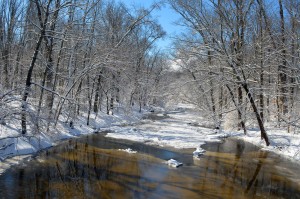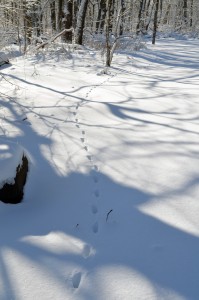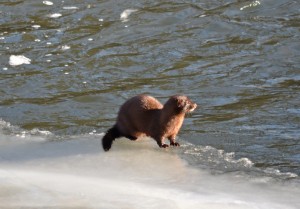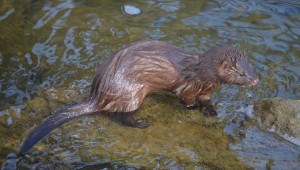I walked slowly along the frozen streambank, the thin sheets of ice that stretched out over the flowing current echoed with loud cracks and knocks. I knew the sounds served as a warning not to venture out any farther, or risk going home very wet and cold. But, I had to get a bit closer to check out the tracks that I discovered on the snow-covered ice packs along the edge of the stream. What animal could have made them? The clues were right in front of me. They were small, about an inch long, showing five toes with claws. The pattern in the snow revealed the animal’s gait (how it was moving). It looked as if it was running, only pausing to investigate an old tree root. The animal was hunting. Then just as quickly as I found them, the tracks were gone, disappearing at the water’s edge. The nature mystery continued.
As I took a step forward, the layer of ice I was standing on suddenly collapsed. My trustworthy, winter boot sunk to the bottom of the small creek like a lead anchor, as frigid water began to pour in. Not only did I proceed to shock my warm, comfy foot, I also made enough noise to scare away any other living animal within one square mile! However, I could easily see across the stream to the other shoreline, and there was no trace of any animal tracks-another clue. I had briefly considered the tracks might have been made by a squirrel, raccoon or even a skunk, but if they had decided to cross the stream I would have easily located their tracks coming out on the other side. So, by process of elimination, it had to have been an aquatic mammal, which could have slipped off the ice and gone under water. In Pennsylvania, that would narrow my findings to possibly four animals-a Beaver, Muskrat, River Otter or Mink. I knew this tributary was too small for a Beaver or Muskrat, which prefer lakes, ponds or deeper, slower-moving rivers or creeks. Lastly, the tracks of a River Otter are much larger, about 3” in length. The source of the prints in the snow had to be from a Mink.
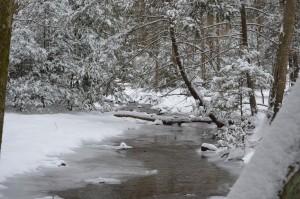
A fresh snow reveals fox tracks leading to a local stream.
Mink are members of the Mustelidae family. Here in the Keystone State, its relatives include the River Otter, Fisher, Striped Skunk and Weasels. In other parts of the U.S. the Badger, Wolverine, Martin and Ferrets are also members of this family. All of these mammals have glands that can produce strong “musk” smells, the most famous is the skunk. Mink are small, slender, mostly dark-colored mammals that live near water. All the ones I’ve seen here in Pennsylvania are chocolate brown-colored, with a small white patch under their chin. I have observed Mink in the Adirondacks in New York that are more slate-gray color.
Mink are carnivores and will eat a variety of food, including fish, frogs, crayfish, mice, snakes or birds. If available, they’ll also prey on muskrats. They live near water, finding an old tree root along a streambank, hollow log or pile of boulders to make their den. Its fur is thick, soft and covered by oil guard hair, which makes it coat waterproof.
In 2015, I was privileged of seeing many Mink in my travels. Maybe it was simply because I got “out and about” more last year, visiting the places they inhabit, or just lucky to be in the right place at the right time. We even have one regular (we think it’s only one) that wanders frequently near our office, which sits along the Perkiomen Creek. Each one I’ve watched, never sat still very long. They would hop and lope along a waterway, zig-zagging all over the place, in and out of holes, fallen trees, rock piles and diving underwater. They reminded me of a small child, full of energy and curiosity, playing on a playground. If they did stop, it was only long enough to eat whatever they caught. These sleek, beautiful animals truly enjoy “living on the edge!”
